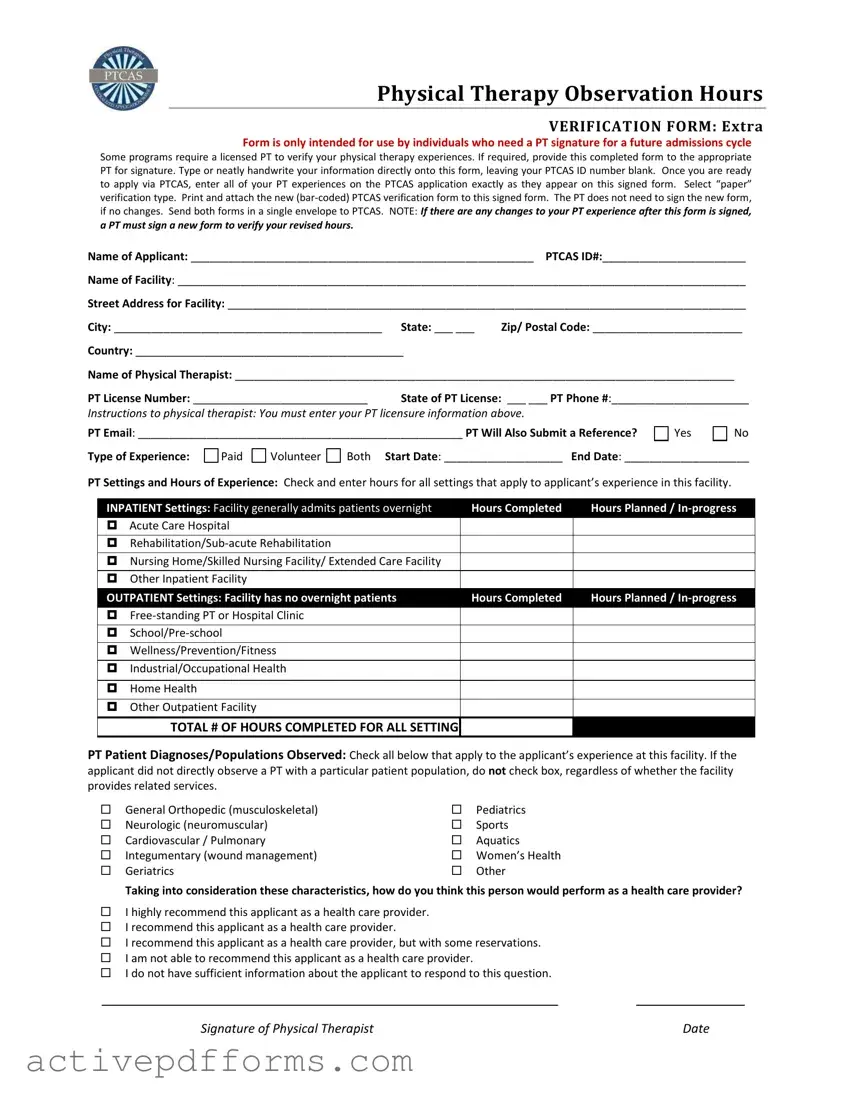Physical Therapy Observation Hours
VERIFICATION FORM: Extra
Form is only intended for use by individuals who need a PT signature for a future admissions cycle Some programs require a licensed PT to verify your physical therapy experiences. If required, provide this completed form to the appropriate PT for signature. Type or neatly handwrite your information directly onto this form, leaving your PTCAS ID number blank. Once you are ready to apply via PTCAS, enter all of your PT experiences on the PTCAS application exactly as they appear on this signed form. Select paper verification type. Print and attach the new (bar-coded) PTCAS verification form to this signed form. The PT does not need to sign the new form, if no changes. Send both forms in a single envelope to PTCAS. NOTE: If there are any changes to your PT experience after this form is signed, a PT must sign a new form to verify your revised hours.
Name of Applicant: _______________________________________________________ PTCAS ID#:_______________________
Name of Facility: ___________________________________________________________________________________________
Street Address for Facility: ___________________________________________________________________________________
City: ___________________________________________ |
State: ___ ___ |
Zip/ Postal Code: ________________________ |
Country: ___________________________________________ |
|
Name of Physical Therapist: ________________________________________________________________________________
PT License Number: ____________________________ State of PT License: ___ ___ PT Phone #:______________________
Instructions to physical therapist: You must enter your PT licensure information above.
PT Email: ____________________________________________________ PT Will Also Submit a Reference? |
Yes |
No |
Type of Experience: |
Paid |
Volunteer |
Both Start Date: ___________________ |
End Date: ____________________ |
PT Settings and Hours of Experience: Check and enter hours for all settings that apply to applica t’s experience in this facility. |
|
|
|
|
|
|
|
|
|
|
|
|
|
|
INPATIENT Settings: Facility generally admits patients overnight |
|
|
Hours Completed |
|
|
Hours Planned / In-progress |
|
|
|
Acute Care Hospital |
|
|
|
|
|
|
|
|
|
|
|
|
|
|
|
|
|
|
|
|
|
|
|
|
|
|
Rehabilitation/Sub-acute Rehabilitation |
|
|
|
|
|
|
|
|
|
|
|
|
|
|
|
|
|
|
|
|
|
|
|
Nursing Home/Skilled Nursing Facility/ Extended Care Facility |
|
|
|
|
|
|
|
|
|
|
|
|
|
|
|
|
|
|
|
|
|
|
|
|
Other Inpatient Facility |
|
|
|
|
|
|
|
|
|
|
|
|
|
|
|
|
|
|
|
|
|
|
OUTPATIENT Settings: Facility has no overnight patients |
|
|
Hours Completed |
|
|
Hours Planned / In-progress |
|
|
|
|
|
|
|
|
|
|
|
|
|
|
|
|
Free-standing PT or Hospital Clinic |
|
|
|
|
|
|
|
|
|
|
|
|
|
|
|
|
|
|
|
|
|
|
|
|
|
|
School/Pre-school |
|
|
|
|
|
|
|
|
|
|
|
|
|
|
|
|
|
|
|
|
|
|
|
|
|
|
Wellness/Prevention/Fitness |
|
|
|
|
|
|
|
|
|
|
|
|
|
|
|
|
|
|
|
|
|
|
|
|
|
Industrial/Occupational Health |
|
|
|
|
|
|
|
|
|
|
|
|
|
|
|
|
|
|
|
|
|
|
|
|
|
|
|
Home Health |
|
|
|
|
|
|
|
|
|
|
|
|
|
|
|
|
|
|
|
|
|
|
|
|
|
|
|
|
Other Outpatient Facility |
|
|
|
|
|
|
|
|
|
|
|
|
|
|
|
|
|
|
|
|
|
|
|
|
TOTAL # OF HOURS COMPLETED FOR ALL SETTING |
|
|
|
|
|
|
|
|
PT Patient Diagnoses/Populations Observed: Check all below that apply to the applica t’s experience at this facility. If the applicant did not directly observe a PT with a particular patient population, do not check box, regardless of whether the facility provides related services.
|
General Orthopedic (musculoskeletal) |
|
Pediatrics |
|
Neurologic (neuromuscular) |
|
Sports |
|
Cardiovascular / Pulmonary |
|
Aquatics |
|
Integumentary (wound management) |
|
Wo e ’s Health |
|
Geriatrics |
|
Other |
Taking into consideration these characteristics, how do you think this person would perform as a health care provider?
I highly recommend this applicant as a health care provider.
I recommend this applicant as a health care provider.
I recommend this applicant as a health care provider, but with some reservations.
I am not able to recommend this applicant as a health care provider.
I do not have sufficient information about the applicant to respond to this question.

